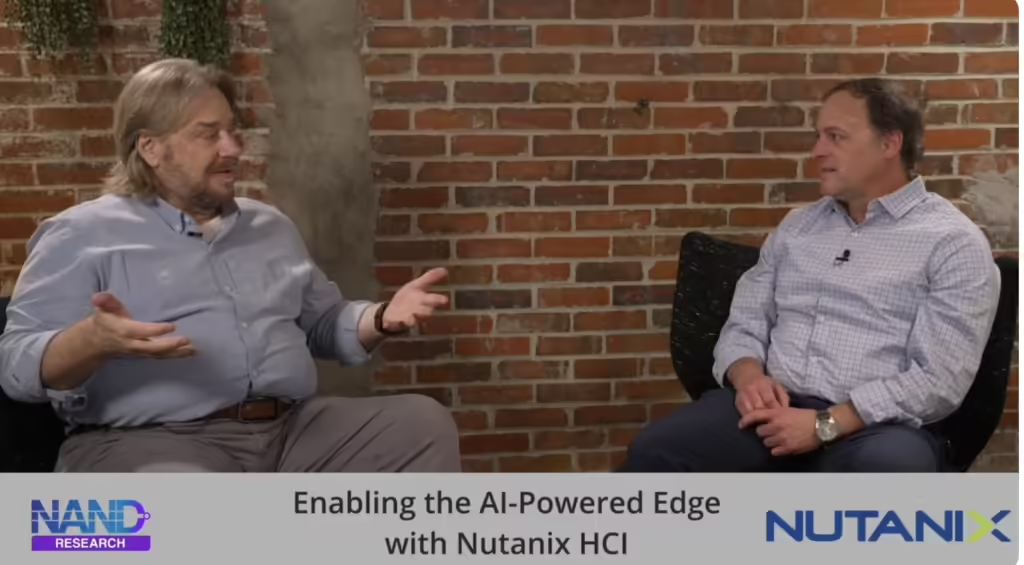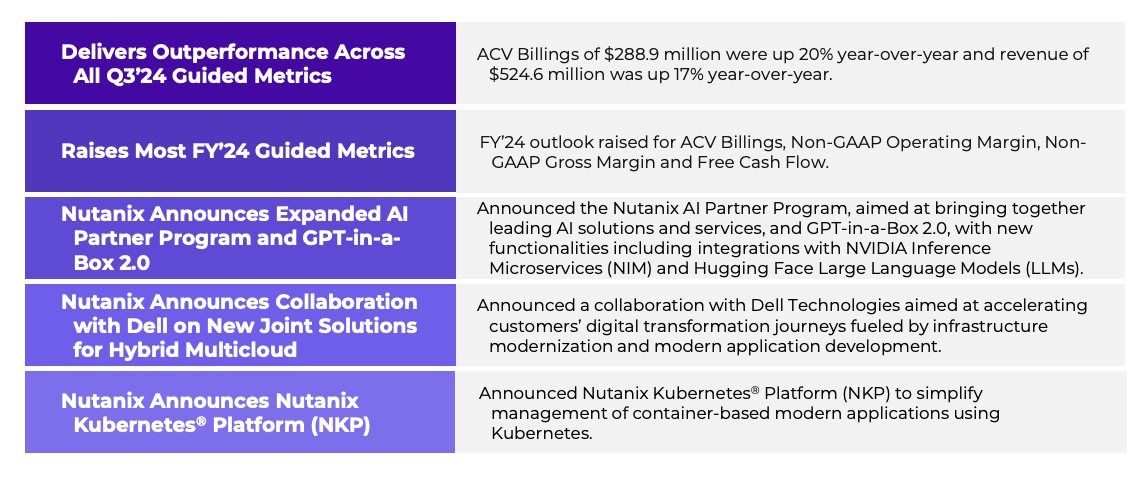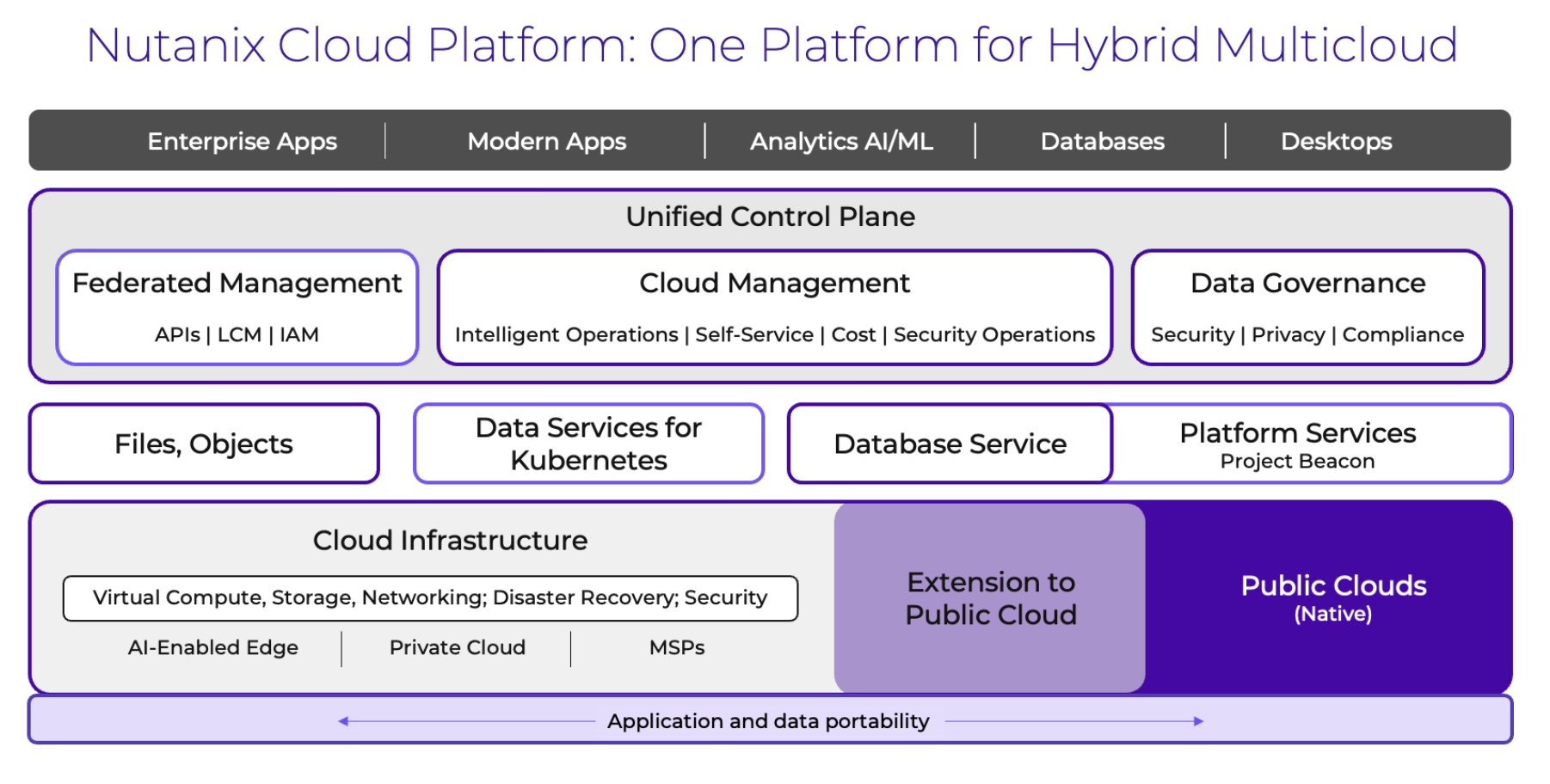Despite the tremendous business benefits of edge computing, it arrives with complex challenges, including managing geographically dispersed nodes, security risks, and integrating with existing IT infrastructure. These challenges can best be addressed with an architecture built around Hyper-Converged Infrastructure, which streamlines management and enhances performance.
I recently sat with Nutanix’s Greg White, Senior Director of Product Marketing, to understand the challenges of deploying resources, including AI, to the edge. Greg also talked in-depth about how hyper-converged architectures (HCI) can be leveraged to address many of these challenges.
Below is a transcript of what was a great conversation (lightly edited for clarity and length).
Steve McDowell: I want to talk about edge and how enterprises are expanding their footprint into the edge, their infrastructure to the edge. But before I do that, I think it makes sense to level set. For a long time. When people think about Nutanix, we think about HCI, hyperconverged infrastructure, and 10 years ago that meant something very specific. It was an appliance, it had compute and storage and networking all in a box, hyperconverged. But that’s changed, right? I mean, how do you view HCI and how does that fit in infrastructure management software?
Greg White: We’ve really seen this evolution. HCI is still really that underpinning. the technology that gets built upon, but it’s those additional services that are really where you see a lot of value added needs for different organizations, whether it’s the data protection piece, whether it’s micro segmentation security, being able to do self-service, all these things that make using that HCI so powerful and so much easier.
Steve: But HCI, it’s wrong to think about it as an appliance?
Greg: Correct.
Steve: It’s more a virtual appliance? Because you’re deploying HCI solutions. You’re deploying HCI solutions to manage cloud resources: Is it really the consolidation of resources with a single management plane or is that the right way to think about it?
Greg: Originally, there’s a pool of resources in HCI was an appliance. Now it could be bare metal in the cloud you’re talking about. It could be one server in an office, it could be a whole pool of them.
It’s really that management of this pool of resources and using software to abstract all the complexity away that’s underneath and running it anywhere on any of those different types of locations.
Steve: And the value that brings me as an IT administrator is really, it simplifies how I manage my infrastructure, right? Because I’m abstracted away from the hardware. I mean, somebody I’m sure cares about what’s in the rack, but most IT administrators don’t. I’m deploying, you guys have database as a service, right? I’m deploying data. It’s all push button and infrastructure management.
Greg: Yeah, it’s this idea of I don’t need to manually do everything. I want to be able to automatically provision a database, a VM, have the right image for a virtual desktop and take all the single steps, the manual steps we used to do in the past and just make that part of the software management of those resources and assigning just the right resource for that workload with the ability to then easily scale it, change it if you need to. You’re not locked in.
Steve: And that makes a lot of sense. I think as HCI has evolved, so as the industry. 10 years ago, cloud had a space, on-prem had a space, but today, if I’m an enterprise, I’m crossing cloud boundaries, have cloud, have on-prem. I might have more than one cloud and using a control plane like Nutanix is delivering a set of features, right, that works across those boundaries?
Greg: Yeah, that’s the great thing about it. It’s running workloads anywhere, but doing it with that same common operating model. So that pool of resources that I have on-prem in my data center, the way I manage and run it and run the workload on Nutanix is the exact same way I do it in AWS or Azure or a service provider cloud as well as all the way at the edge.
Steve: That’s what I want to talk about. I want to talk about that running an anywhere piece because in my mind, managing cloud resources doesn’t look that different from managing on-prem. I mean, you don’t get to touch the hardware, but the same buckets are there.
What we’ve seen happen in enterprise IT over the past, say five years is kind of the explosive growth of edge. Some of this was enabled by 5G, a lot of it was enabled by 5G. And then I think it’s being accelerated right now with AI at the edge and deploying, extending my IT infrastructure to the edge has its own unique set of challenges.
It doesn’t look like a traditional data center from the physical location on up. What are you seeing? Well, first validate that, right? Are we seeing increased adoption of edge?
Greg: Yeah, yeah. I think the other thing is there’s all these new workloads and use cases as we’ve gotten more into customer experience into using video analysis. You’re talking kind of the old school AI as well as the gen AI piece, but we’re seeing just a lot more different needs for IT and data collection and analysis and doing real time decision making locally.
You can’t send it all the way back to the cloud or all the way back to the data center to do some of the things we need to do. Manufacturing is another area. I guess the big thing to think that I have found that’s changed is the way we talk about edge has changed and evolved too. There’s big edge deployments in a manufacturing facility. There’s smaller at a retail store and then you’re even getting down to just one node kind of deployments.
Steve: But even in a retail environment, again, I’m looking at this from perspective of the IT guy, it may be one or two nodes I can run fault resilient in a location, but I might have 10,000 of those locations. So suddenly again, as an IT administrator, I have to care about fleet management. I never had to care about that with cloud.
So how do I do patches? How do I do software updates? I mean a whole host of concerns, right? Security is different. I don’t have physical security. I might have to work offline, disconnected because if I’m a retail store, lines go down all the time. So how do I address those challenges? Is HCI or an HCI centered solution?
Greg: The edge ROBO has always been a huge area for Nutanix because hyperconverged infrastructure really plays well to the things you talked about. One, that consolidation of resources, compute storage and all that. But that management layer on the top, that helps with my upgrades, it helps with my data protection, that helps with managing my resources and optimizing that works great in the data center, but it’s perfect for also doing that at that scale.
You can’t go, even you want to deploy a new app to your 10,000 stores, to manually go add that app. And if you have the ability with HCI in that management piece to have a blueprint that just goes and deploys the exact same way every time, and it eliminates a lot of that challenge of manually doing things at scale. So it really plays a huge part.
Steve: Okay, so we talked about retail and I think that’s an obvious one. The back of a retail store, I don’t know our viewers, our listeners would be surprised to learn is a small data center. And it’s been that way forever because every time I’m doing a barcode scan, it’s hitting a database on-prem. But where else are you seeing edge expand? I mean, my perception is it’s going to hit every organization that has an external footprint at some point, right? Are you seeing that?
Greg: Yeah. I mean, we have some interesting applications like in drill rigs. We see that. I was hearing from a customer just a couple months ago, drilling services company and they were bringing in AI and computer vision for safety. So they have cameras around the well head and cameras on the rigs, and they’re watching to see if dirt’s moving, if somebody’s too close to the well and they can alert. So AI doing the work of somebody having to sit there and watch.
We see small ships and drill rigs and that kind of size but also you’re talking about more workloads in more places. A customer was talking about putting in loan application analysis using AI, but wanting to do it in branches. So the regulations in this state are different from that state. So we want the model to be here and for this location kind of thing. So really seeing interesting new uses of AI, of edge.
Steve: When I started looking at how IT is extending to the edge, there’s a lot of people, there are a lot of people that are saying, “I don’t need management software. Containers solve my problem.” I think one of the earliest container demos I saw was at a vendor conference from their labs. They never productize this, but they’re running Kubernetes because it solves a lot of these same problems, allows me to dynamically push workloads out. But it only goes so far in the solution set.
How do you look at containers and how that fits? Is OpenShift an alternative to Nutanix or do you say no, these are kind of complementary?
Greg: We really look at it like what you’re saying in that complementary aspect, because there are still pieces of that infrastructure management, there’s data protection. There’re other areas where you can, that container management, that fleet management, and especially at scale is how and HCI-based platform really complements what’s done there.
And we like to think about all the things we did for virtualization and made it so easy to deploy VMs and the right resources. We’re doing the same thing on the container front. And so container is just that layer that uses the software defined infrastructure optimally and more easily.
Steve: So you’re not forcing a model that says, “I have to use a AHV,” that’s your hypervisor, right?
Greg: Right.
Steve: That I have to use AHV and virtualize everything if I’m going down the path of containerization. And a lot of people are just from an application development perspective, that’s there.
Greg: Yeah, absolutely. And we think of, that’s why we talk about it as a cloud platform. It’s where you can run your VMs, you can run your Kubernetes, and we’re even adding the enterprise data services that Kubernetes needs. A lot of customers, they can kind of do some containerization manually. There are ways for having those drivers and the CSIs into storage, but it’s still kind of challenging and especially at scale. And so we’ve added those enterprise data services in for cloning and data protection, all that sort of thing.
Steve: But you take a relatively open approach, as I understand it, Nutanix, you may dictate capabilities or recommend capabilities, but you don’t dictate a hardware platform?
Greg: Correct.
Steve: You’re open. So if I’m using a Dell Power Edge or power scale, and they have CSI drivers, that just kind of works in the solution stack?
Greg: Yeah. And you can think we have the flexibility on the front end. You can pick the Kubernetes flavor you want, but it just a great one. Others, we have a built-in Kubernetes engine within that some customers use as well.
And then on the back end too, the hardware side, whether it’s Dell or HPE or Lenovo or Cisco, on and on, and then Super Micro as well is another one. But we have those. We’ve made it easy to use all those. And then that gives the customer the flexibility to pick. They are people that have affinity for different ones for different reasons, and that’s great. We want to help them do that.
Steve: Let’s talk about that choice a little bit. When I talk about hyperconverged, how far does that converge go? You talk about data protection a little bit. A lot of organizations have their favorite data protection solution, or observability is something you don’t take on, or cybersecurity, but it’s core to how people manage their infrastructure.
So how open and easy to integrate a Nutanix solution, or is it to integrate a Nutanix solution into third party?
Greg: A big focus, the partner, the technology alliance piece is a huge focus for us. We have APIs that allow you, to third party or an organization to do some of those integrations. We’ve also done some of that integration qualification work as well. I mean, think of a Haiku or a Veeam that really has a little bit more integration into what we do from the data protection side. We believe there’s that, that ecosystem is so important, and so we’ve made it easy for them to interact and work together.
Steve: It’s been a big year for AI in the industry. I think we’re at a point now where when people say AI, our minds immediately go to generative AI, large language models. But I think as we alluded to earlier, that’s not the AI we’re seeing at the edge. Not yet. It’s coming.
We’re really seeing things like vision processing. It’s just your, I don’t want to say boring, but it’s kind your inference and you support that, right? Nutanix has, you do GP pass through. So whatever accelerator I need to have, that’s present?
Greg: Yes.
Steve: And if I want to use large language models, you even have GPT-in-a-box, which is kind of a cool reference design.
Greg: We started getting a lot of inquiries as this generative AI thing has blown up. We’ve been doing AI for a long time. We talked about, there’s, I saw a tweet the other day from Tractor Supply where they were talking about how they just rolled out a camera vision for if somebody is over by the propane tanks and somebody out there to fill it for them. If there are too many people in line, send an alert to the store to have people come, using that computer piece, a vision piece.
But we’re also now seeing this need for a little bit more, a little different. And so we did GPT-in-a-box, which is basically an opinionated stack of what are the pieces you need to deploy a model with the data flows, have the storage, the file object-
Steve: So it’s kind of like a validated design, reference architecture kind of thing?
Greg: Yeah. With some services to help move it along. Really the idea is to get to pilot quicker, to get to production more easily and have this predefined piece with services where you help scope out what you’re going to do, decide on your deployment, and then actually get everything going.
That common operating model that we talked about running anywhere, that idea, “Okay, I’m going to run the model here at the edge, but then once a quarter I may want to send it back to the data center, update it with new data, maybe regulations, change for that loan analysis, and then send the model back.” And you don’t have to recreate it every time and have different underlying infrastructures it’s running on.
Steve: And we’re going to see more of that. I think we’re going to see generative AI and large language models. It’s going to be retail first. It’s all about the user experience. We’re already doing self-checkout. We’re already doing self-banking. It’s going to be that virtual agent in front of you which needs to run locally. You’re talking about a lot of stuff.
The beauty of HCI or an HCI based architecture has always been simplicity, but yet, you’re talking about a lot of moving parts. I go to nutanix.com and I pull up your portfolio picture and I’m just lost. There’s like 75 different pieces that, it seems like a lot of choice.
Is that deceptive? Is it really simple? And how are you guys helping onboard new customers who may not be familiar? Because a lot of people are coming from VMware, A lot of people are coming from containers. A lot of people are just coming from the street, right?
Greg: That first move from legacy to HCI is. But yeah, I mean there are a lot of different services, but it’s all that central management plane that we call Prism, but it’s all through that same pane of glass. So I can go in and I can see what my VMs are doing. I can see containers. I can see locations for the edge. I can put tags on them, so that this is a small location, or this is Northeast.
And then you can filter and do your work based on those tags. You don’t have to know every name of everything. So there are different pieces like that, but it’s all managed through that same pane of glass, same experience. And we apply that this one click philosophy.
We want to make everything one click, simple. Want to do an upgrade, it’s one click, that kind of thing. So that HCI and the management software defined piece helps make that real.
Steve: Thank you, Greg for taking the time.
Greg: I really enjoyed it. I’ve learned some stuff here too, so that’s great.




